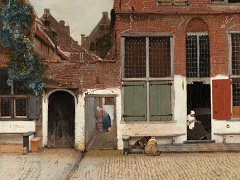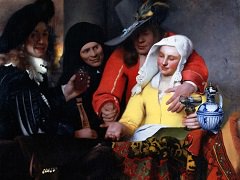The Guitar Player, 1672 by Johannes Vermeer

The Guitar Player is one of the most beautiful examples of Vermeer's late style. The crispness of his image and the radiant colors give the painting a glowing quality. Vermeer, in his
paintings of the 1670s, was no longer concerned with describing specific textures of materials. Brushstrokes became freer and more expressive than in his earlier works as he emphasized patterns
of color rather than textures. Vermeer modeled the girl's dress and jacket, for example, with sharply defined planes of color. The subtle modulations in folds and contours that he formerly created
by applying glazes oveF opaque paints are no longer evident. The face also is treated differently. Its expression is outward and not self-contained. The nuances of shading that suggested
qualities of character and personality have been replaced by distinctly separate areas of light and shade. The interest in pattern is evident in the ringlets of hair silhouetted against the wall.
Together with The Lacemaker, this painting constitutes one of the best achievements by Vermeer, and certainly a towering success in his late maturity. By now,
the artist had attained the mastery of light and colours, together with complete freedom of expressing himself technically by means of looser brushstrokes that are no longer bound to specifics
of texture or materials. The model is not drawn inward but looks to the outside world in full communication and radiance of her pleasure simply to make music. Never was Vermeer more able to
liberate himself from all constraints and convey his artistic viewpoint in a more masterly manner. The landscape on the back wall seems to be painted in the style of Hackaert.




















